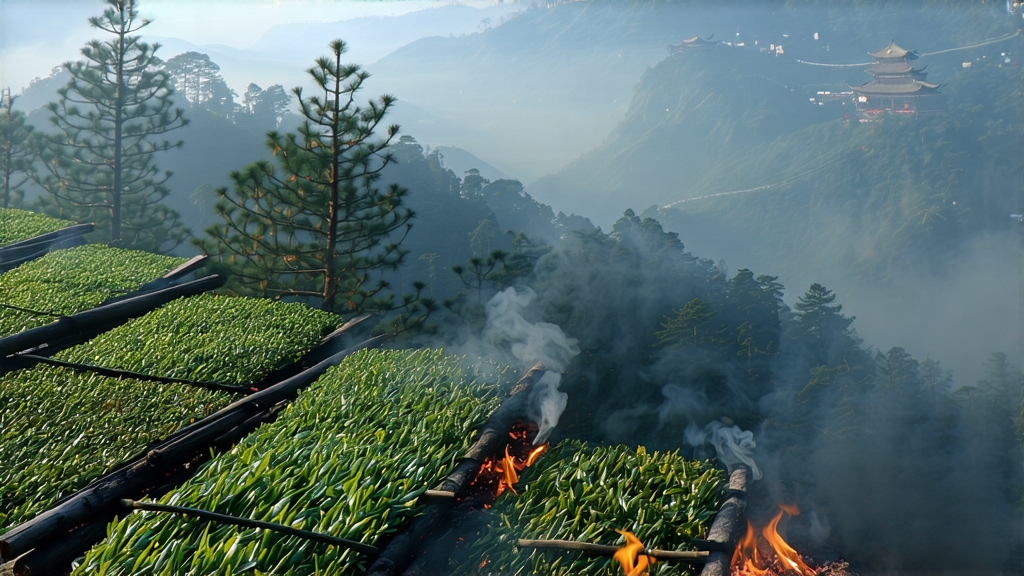
Long before Assam, Ceylon, or Earl Grey entered the global lexicon, the cliffs of northern Fujian echoed with the crackle of pine torches and the rustle of tea leaves. There, in the Wuyi Mountains, Lapsang Souchong—today celebrated as the first black tea ever created—was born out of accident, ingenuity, and the timeless dialogue between fire and leaf. To international drinkers the name may conjure images of campfires in a cup, yet beneath its smoky perfume lies a lineage that shaped every black tea that followed. This article invites you to travel beyond the stereotype, exploring the history, terroir, craftsmanship, and ritual that elevate Lapsang Souchong from curio to connoisseur’s treasure.
-
Historical backdrop
The year most scholars cite is 1646, when Qing armies swept through Fujian and disrupted the late-harvest routine of Tongmu village farmers. To hasten drying and appease demanding troops, the villagers spread fresh leaves over pine embers. The resulting tea, marked by a heady smoke aroma, reached European merchants via the Dutch East India Company and quickly captivated London society. By the early eighteenth century “bohea” (the corruption of “Wuyi”) had become a generic English term for black tea, and Lapsang Souchong—literally “small plant from the original mountain”—was its aristocratic flagship. Catherine of Braganza’s dowry chest allegedly contained several tins, cementing the tea’s royal cachet and fueling demand that would ultimately inspire British botanists to transplant Camellia sinensis to India. -
Terroir and cultivar
Tongmu sits in a granite gorge at 27° N latitude, where the Min River carves mist-laden valleys whose diurnal temperature swing can exceed 15 °C. The forest is 96 % original cover, dominated by Masson pine and bamboo whose roots filter mineral-rich spring water. Only two clonal cultivars are permitted under the Tongmu Protected Geographical Indication: Xiao Ye Zhong (“small-leaf”) and the rarer Ye Sheng (“wild”). Their leaves are unusually thick, storing more polyphenols and soluble sugars—precursors to both malt sweetness and the capacity to absorb smoke without turning acrid. -
Harvest calendar
Plucking follows the lunar calendar. The earliest spring pick, Qingming qian (before April 5), yields buds still sheathed in down, reserved for the unsmoked, honeyed grade known as “Zheng Shan Xiao Zhong.” After Qingming, one leaf and a bud become the standard for classic Lapsang, while the May rains produce larger, woodier material destined for stronger smoking. No summer tea is plucked; the plants are allowed to rest and accumulate aromatic oils. -
Traditional processing
Withering begins on bamboo screens set above riverside huts, where pine smoke drifts through louvered windows. Over eight hours the leaf moisture drops from 75 % to 58 %, while guaiacol and syringol—the signature smoke phenols—bind to leaf surfaces. Rolling is still done by foot in a 1.2-meter diameter fir vat; the barefoot craftsman rocks back and forth exactly 64 times per batch, a rhythm learned from fathers and grandfathers. Oxidation lasts 3.5 hours in cedar-lined chests kept at 24 °C and 85 % humidity, the leaf turning from jade to copper. The crucial smoking stage follows: layers of tea are alternated with layers of pine needles and bark inside brick kilns fired by longan wood. Temperature is held below 80 °C to avoid scorching, yet the leaves spend up to 20 hours in this fragrant sauna, emerging mahogany-black and glossy. A final charcoal bake, using embers of 30-year-old camphor tree roots, fixes the aroma and adds a cooling menthol echo. -
Grades and styles
- Zheng Shan Xiao Zhong (unsmoked): Dried over hot air rather than pine, it surprises newcomers with notes of longan fruit, raw cacao, and a lingering sweet potato finish.
- Classic Lapsang: Medium smoke, cocoa-like body, balanced by hints of cinnamon bark.
- Tarry Lapsang: Heavy smoke, reminiscent of tar and leather, preferred by Russian markets; often brewed samovar-style with sugar.
- Special Pine Tip: Made only from buds, smoked for just two hours, then rested in oak barrels for six months; the liquor is champagne-amber and